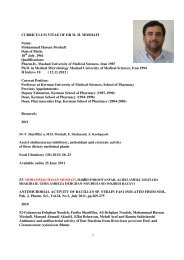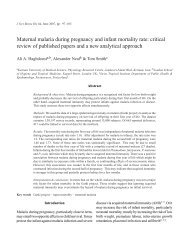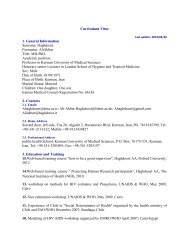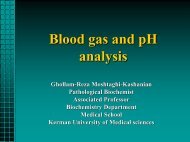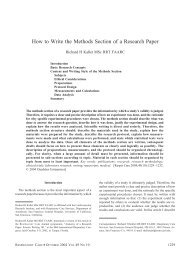Research priorities in the field of HIV and AIDS in Iran
Research priorities in the field of HIV and AIDS in Iran
Research priorities in the field of HIV and AIDS in Iran
Create successful ePaper yourself
Turn your PDF publications into a flip-book with our unique Google optimized e-Paper software.
Orig<strong>in</strong>al article<br />
<strong>Research</strong> <strong>priorities</strong> <strong>in</strong> <strong>the</strong> <strong>field</strong> <strong>of</strong> <strong>HIV</strong> <strong>and</strong> <strong>AIDS</strong> <strong>in</strong><br />
<strong>Iran</strong><br />
AliAkbar Haghdoost 1 , Masoomeh Sadeghi 2 , Maryam Nasirian 2 , Ali Mirzazadeh 3 ,<br />
Soodabeh Navadeh 3<br />
1<br />
Associate Pr<strong>of</strong>essor, <strong>Research</strong> Centre for Model<strong>in</strong>g <strong>in</strong> Health, Kerman University <strong>of</strong> Medical Sciences, Kerman, <strong>Iran</strong>. 2 MSc<br />
Student, Regional Knowledge Hub for <strong>HIV</strong>/<strong>AIDS</strong> Surveillance, Kerman University <strong>of</strong> Medical Sciences, Kerman, <strong>Iran</strong>. 3 PhD<br />
C<strong>and</strong>idate, Regional Knowledge Hub for <strong>HIV</strong>/<strong>AIDS</strong> Surveillance, Kerman University <strong>of</strong> Medical Sciences, Kerman, <strong>Iran</strong>.<br />
Background: <strong>HIV</strong> is a multidimensional problem. Therefore, prioritization <strong>of</strong> research topics <strong>in</strong> this <strong>field</strong> is a serious challenge. We<br />
decided to prioritize <strong>the</strong> major areas <strong>of</strong> research on <strong>HIV</strong>/<strong>AIDS</strong> <strong>in</strong> <strong>Iran</strong>. Materials ans Methods: In a bra<strong>in</strong>-storm<strong>in</strong>g session with <strong>the</strong><br />
ma<strong>in</strong> national <strong>and</strong> prov<strong>in</strong>cial stakeholders <strong>and</strong> experts from different relevant <strong>field</strong>s, <strong>the</strong> direct <strong>and</strong> <strong>in</strong>direct dimensions <strong>of</strong> <strong>HIV</strong>/<strong>AIDS</strong><br />
<strong>and</strong> its related research issues were explored. Afterward, us<strong>in</strong>g <strong>the</strong> Delphi method, we sent questionnaires to 20 experts (13 respondents)<br />
from different sectors. In this electronic based questioner, we requested experts to evaluate ma<strong>in</strong> topics <strong>and</strong> <strong>the</strong>ir subtopics.<br />
The ranges <strong>of</strong> scores were between 0 <strong>and</strong> 100. Results: The score <strong>of</strong> <strong>priorities</strong> <strong>of</strong> ma<strong>in</strong> <strong>the</strong>mes were preventive activities (43.2),<br />
large scale plann<strong>in</strong>g (25.4), <strong>the</strong> estimation <strong>of</strong> <strong>the</strong> <strong>HIV</strong>/<strong>AIDS</strong> burden (20.9), <strong>and</strong> basic scientific research (10.5). The most important<br />
priority <strong>in</strong> each ma<strong>in</strong> <strong>the</strong>me was education particularly <strong>in</strong> high risk groups (52.5), develop<strong>in</strong>g <strong>the</strong> national strategy to address <strong>the</strong> epidemic<br />
(31.8), estimation <strong>of</strong> <strong>the</strong> <strong>in</strong>cidence <strong>and</strong> prevalence among high-risk groups (59.5) <strong>and</strong> develop<strong>in</strong>g new preventive methods<br />
(66.7), respectively. Conclusions: The most important <strong>priorities</strong> <strong>of</strong> researches on <strong>HIV</strong>/<strong>AIDS</strong> were preventive activities <strong>and</strong> develop<strong>in</strong>g<br />
national strategy. As high risk groups are <strong>the</strong> most <strong>in</strong>volved people <strong>in</strong> <strong>the</strong> epidemic, <strong>and</strong> <strong>the</strong>y are also <strong>the</strong> most hard-to-reach subpopulations,<br />
a national well designated comprehensive strategy is essential. However, we believe with a very specific <strong>and</strong> directed<br />
scheme, special attention to research <strong>in</strong> basic sciences is necessary, at least <strong>in</strong> limited number <strong>of</strong> <strong>in</strong>stitutes.<br />
Key words: <strong>HIV</strong>, <strong>AIDS</strong>, Priority, <strong>Iran</strong>.<br />
INTRODUCTION<br />
Nowadays, human immunodeficiency virus (<strong>HIV</strong>)<br />
<strong>in</strong>fection is a global health concern <strong>and</strong> nearly all <strong>of</strong><br />
countries face with its social, cultural, economic <strong>and</strong><br />
political consequences. [1] Globally, <strong>the</strong> number <strong>of</strong><br />
<strong>HIV</strong> positives is remarkable <strong>and</strong> it has an <strong>in</strong>creas<strong>in</strong>g<br />
trend. It was estimated that 33.2 million people are<br />
liv<strong>in</strong>g with <strong>HIV</strong> all around <strong>the</strong> world; 2.5 million<br />
people have become newly <strong>in</strong>fected <strong>and</strong> 2.1 million<br />
people die <strong>of</strong> <strong>AIDS</strong>. [2] Most <strong>of</strong> <strong>the</strong> new cases are occurr<strong>in</strong>g<br />
<strong>in</strong> develop<strong>in</strong>g countries <strong>and</strong> among young<br />
population which are <strong>the</strong> productive part <strong>of</strong> <strong>the</strong><br />
population .[3,4] This potential hazard is prom<strong>in</strong>ent <strong>in</strong><br />
East Mediterranean region (EMR) countries <strong>in</strong>clud<strong>in</strong>g<br />
Islamic Republic <strong>of</strong> <strong>Iran</strong>. [5]<br />
Based on available statistics, <strong>Iran</strong> similar to many<br />
o<strong>the</strong>r countries <strong>in</strong> EMR, is fac<strong>in</strong>g with concentrated<br />
epidemic level for <strong>HIV</strong> <strong>in</strong>fection from a few years<br />
ago. [6] Accord<strong>in</strong>g to <strong>the</strong> latest United Nations General<br />
Assembly Special Session (UNGASS) report <strong>in</strong><br />
2010 more than 22000 <strong>HIV</strong> positive cases had been<br />
identified <strong>in</strong> <strong>Iran</strong> until September 2009; however,<br />
United Nations <strong>AIDS</strong> (UN<strong>AIDS</strong>) estimates that<br />
86000 people are liv<strong>in</strong>g with <strong>HIV</strong> <strong>in</strong> <strong>Iran</strong>. [7,8]<br />
Based on <strong>the</strong> above explanation, we have to comprehensively<br />
approach to <strong>HIV</strong> <strong>in</strong>fection. <strong>HIV</strong> <strong>in</strong>fection<br />
has many aspects, from molecular to social <strong>and</strong><br />
political aspects. Hence, to tackle with this threat,<br />
many sectors <strong>and</strong> discipl<strong>in</strong>es have to work toge<strong>the</strong>r<br />
efficiently. In addition, because <strong>of</strong> many dilemmas<br />
<strong>in</strong> this <strong>field</strong> with specific responses that are compatible<br />
with local cultures, community oriented research<br />
plays a very important role. Therefore, we<br />
believe that a comprehensive map for researches<br />
based on a need assessment project is necessary.<br />
Our literature review showed that such a need assessment<br />
for <strong>the</strong> research topics is miss<strong>in</strong>g <strong>in</strong> many<br />
develop<strong>in</strong>g countries <strong>in</strong>clud<strong>in</strong>g <strong>Iran</strong>.<br />
In this project, we assessed <strong>the</strong> research needs <strong>in</strong><br />
<strong>HIV</strong> <strong>field</strong>. However, s<strong>in</strong>ce <strong>HIV</strong> is multidiscipl<strong>in</strong>ary<br />
topic, we prioritized four needed research <strong>field</strong>s<br />
(topics); first, horizontal prioritization, <strong>the</strong>n with<strong>in</strong><br />
each topic, we weighted subtopics (vertical prioritization).<br />
The ma<strong>in</strong> objective <strong>of</strong> this study was to<br />
create a comprehensive research map <strong>of</strong> topics <strong>and</strong><br />
sub‐topics <strong>in</strong> <strong>the</strong> <strong>field</strong> <strong>of</strong> <strong>HIV</strong>/<strong>AIDS</strong> <strong>and</strong> weight<br />
<strong>the</strong>se <strong>the</strong>mes based on <strong>the</strong>ir <strong>priorities</strong> us<strong>in</strong>g <strong>the</strong> expert<br />
op<strong>in</strong>ions <strong>in</strong> <strong>Iran</strong>.<br />
Address for correspondence: Soodabeh Navadeh, PhD C<strong>and</strong>idate, Regional Knowledge Hub for <strong>HIV</strong>/<strong>AIDS</strong> Surveillance, Kerman University<br />
<strong>of</strong> Medical Sciences, Kerman, <strong>Iran</strong>. Email: s.navadeh@hivhub.ir<br />
Received: 17-02-2011; Revised: 25-03-2012; Accepted: 30-05-2012<br />
| May 2012 | Journal <strong>of</strong> <strong>Research</strong> <strong>in</strong> Medical Sciences 481
MATERIALS AND METHODS<br />
In a bra<strong>in</strong>‐storm session with <strong>the</strong> ma<strong>in</strong> national <strong>and</strong><br />
prov<strong>in</strong>cial stakeholders, direct <strong>and</strong> <strong>in</strong>direct dimensions<br />
<strong>of</strong> <strong>HIV</strong>/<strong>AIDS</strong> <strong>and</strong> its related research issues were explored.<br />
The stakeholders were <strong>the</strong> experts <strong>in</strong> subnational/national<br />
<strong>and</strong> <strong>in</strong>ternational <strong>in</strong>stitutes work<strong>in</strong>g<br />
<strong>in</strong> <strong>the</strong> cl<strong>in</strong>ical <strong>field</strong>s <strong>of</strong> <strong>HIV</strong> treatment, care <strong>and</strong> support<br />
<strong>and</strong> also those <strong>in</strong>volved <strong>in</strong> <strong>the</strong> basic <strong>and</strong> applied research<br />
<strong>and</strong> surveillance. We designed a questionnaire<br />
based on <strong>the</strong> conceptual diagram (Figure 1) which had<br />
achieved <strong>in</strong> <strong>the</strong> previous step. This questionnaire was<br />
categorized <strong>in</strong>to four ma<strong>in</strong> topics based on <strong>the</strong> most<br />
important research <strong>field</strong>s <strong>in</strong> <strong>HIV</strong>/<strong>AIDS</strong> that were labeled<br />
1) preventive measure, 2) estimat<strong>in</strong>g burden <strong>of</strong><br />
<strong>in</strong>fection, 3) basic research, <strong>and</strong> 4) national <strong>and</strong> sub<br />
national plann<strong>in</strong>g. Each topic consisted <strong>of</strong> some subtopics<br />
<strong>and</strong> 40 subtopics <strong>in</strong> total were def<strong>in</strong>ed.<br />
Afterward, we created a list <strong>of</strong> <strong>Iran</strong>ian experts <strong>in</strong> all<br />
different <strong>field</strong>s <strong>of</strong> <strong>HIV</strong>/<strong>AIDS</strong> from <strong>the</strong> list <strong>of</strong> correspond<strong>in</strong>g<br />
authors <strong>of</strong> <strong>the</strong> papers/documents published<br />
dur<strong>in</strong>g five years before <strong>the</strong> study. We searched <strong>the</strong><br />
entire local (<strong>Iran</strong>medex, SID, Magiran) <strong>and</strong> <strong>in</strong>ternational<br />
(Medl<strong>in</strong>e, Embase, Cochrane Library) databases<br />
as well as <strong>the</strong> CDC‐M<strong>in</strong>istry <strong>of</strong> Health website with a<br />
highly sensitive search strategy for <strong>HIV</strong>/<strong>AIDS</strong> related<br />
<strong>field</strong>s. We have used <strong>HIV</strong>, <strong>AIDS</strong>, second generation<br />
surveillance, most‐at‐risk populations, female sex<br />
workers, men who have sex with men, <strong>in</strong>ject<strong>in</strong>g drug<br />
users, national strategies. We have chosen those<br />
records address<strong>in</strong>g a strategic areas <strong>in</strong> <strong>HIV</strong> epidemic<br />
<strong>and</strong> response at prov<strong>in</strong>cial <strong>and</strong> national level (with<strong>in</strong><br />
<strong>the</strong> past years). Then, we extracted <strong>the</strong> names <strong>and</strong> (e)<br />
mail<strong>in</strong>g addresses <strong>of</strong> <strong>the</strong> correspond<strong>in</strong>g authors which<br />
consisted <strong>of</strong> near to 120 records (20 correspond<strong>in</strong>g authors).<br />
The questionnaire was emailed to all people by<br />
email merg<strong>in</strong>g system <strong>of</strong> MS‐<strong>of</strong>fice. If someone did not<br />
response to <strong>the</strong> first email, ano<strong>the</strong>r request was sent.<br />
The experts were asked to score <strong>the</strong> four ma<strong>in</strong> topics<br />
(step 1) from 0 to 100. In <strong>the</strong> second step, <strong>the</strong>y were<br />
asked to score all <strong>the</strong> subtopics <strong>in</strong> each topic aga<strong>in</strong><br />
from 0 to 100. They cont<strong>in</strong>ued this scor<strong>in</strong>g till to <strong>the</strong><br />
last level. F<strong>in</strong>ally, <strong>the</strong> data were entered <strong>in</strong>to <strong>and</strong> analyzed<br />
by STATA v.10. The 5% trimmed mean <strong>of</strong> scores<br />
was reported as <strong>the</strong> priority score for each topic <strong>and</strong><br />
followed <strong>in</strong> each topic <strong>in</strong> different subtopics.<br />
RESULTS<br />
Out <strong>of</strong> 20 experts, we received 13 filled questioners<br />
(65% response rate). Among <strong>the</strong> ma<strong>in</strong> four topics, preventive<br />
activities got <strong>the</strong> maximum score (43.2 out <strong>of</strong><br />
Haghdoost, et al. <strong>Research</strong> <strong>priorities</strong> <strong>in</strong> <strong>HIV</strong>/<strong>AIDS</strong><br />
100), after that, national <strong>and</strong> sub national plann<strong>in</strong>g<br />
(25.4), <strong>the</strong> estimation <strong>of</strong> <strong>HIV</strong>/<strong>AIDS</strong> burden (20.9), <strong>and</strong><br />
basic researches (10.5) were scored, respectively (Figure<br />
2).<br />
The most important subtopics for research<strong>in</strong>g <strong>in</strong> preventive<br />
activities were education (52.5) <strong>in</strong> high risk<br />
groups, general population <strong>and</strong> partners <strong>of</strong> <strong>in</strong>fected<br />
cases. The second important priority <strong>in</strong> this topic were<br />
<strong>in</strong>terruption <strong>of</strong> transmission cha<strong>in</strong> (47.5) by condom<br />
promotion, clean <strong>in</strong>jection, safe sex, safe blood transfusion<br />
<strong>and</strong> prenatal care programs, respectively. In <strong>the</strong><br />
national <strong>and</strong> sub national plann<strong>in</strong>g, <strong>the</strong>re were five<br />
subtopics ranked <strong>in</strong> this order: top national managerial<br />
organization (31.8), health system (31.2), cultural/ education<br />
system (13.2), legal system (12.9), mass media<br />
(11.2). In <strong>the</strong> estimation burden <strong>of</strong> <strong>in</strong>fection, <strong>in</strong>cidence<br />
<strong>and</strong> prevalence <strong>in</strong> high risk groups/general population<br />
(59.5), its direct <strong>and</strong> <strong>in</strong>direct consequence <strong>and</strong> complications<br />
(23.3), its <strong>in</strong>direct consequences <strong>and</strong> complication<br />
(17.1) were <strong>priorities</strong> <strong>in</strong> <strong>the</strong> estimation burden <strong>of</strong><br />
<strong>the</strong> <strong>in</strong>fection topic. At last, basic researches topic consists<br />
<strong>of</strong> research<strong>in</strong>g <strong>in</strong> new preventive methods (66.7)<br />
<strong>and</strong> new treatments (33.3) subsections. Of course, each<br />
<strong>of</strong> <strong>the</strong>se subsections were aga<strong>in</strong> divided which are<br />
shown <strong>in</strong> table 1.<br />
DISCUSION<br />
Based on our results, preventive activities, national <strong>and</strong><br />
sub‐national plann<strong>in</strong>g, estimat<strong>in</strong>g burden <strong>of</strong> <strong>the</strong> <strong>in</strong>fection<br />
<strong>and</strong> basic researches were <strong>the</strong> topics with highest<br />
<strong>priorities</strong> <strong>in</strong> <strong>HIV</strong>/<strong>AIDS</strong> researches, respectively. Here,<br />
we have presented <strong>the</strong> ma<strong>in</strong> agreed filed on <strong>the</strong><br />
<strong>HIV</strong>/<strong>AIDS</strong> research, <strong>and</strong> discarded <strong>the</strong> outlier rank<strong>in</strong>g<br />
scores by trimmed mean.<br />
The highest priority was assigned to research <strong>in</strong> preventive<br />
dimensions which call for education about <strong>the</strong><br />
content <strong>of</strong> disease, transmission <strong>and</strong> preventive <strong>in</strong>terventions.<br />
But this is important that education covers<br />
<strong>the</strong> vary<strong>in</strong>g groups <strong>of</strong> community, especially <strong>the</strong> high<br />
risk groups <strong>and</strong> <strong>the</strong>n general population. Although <strong>the</strong><br />
grow<strong>in</strong>g epidemic <strong>of</strong> <strong>HIV</strong>/<strong>AIDS</strong> <strong>in</strong> <strong>Iran</strong> needs enhanc<strong>in</strong>g<br />
public awareness, decreas<strong>in</strong>g <strong>the</strong> vulnerability <strong>of</strong> at<br />
risk <strong>and</strong> high risk populations through free counsel<strong>in</strong>g<br />
<strong>and</strong> cl<strong>in</strong>ical services <strong>and</strong> lower<strong>in</strong>g <strong>the</strong> exist<strong>in</strong>g level <strong>of</strong><br />
stigmatization <strong>and</strong> discrim<strong>in</strong>ation are necessary. Kaushik<br />
et al. showed that <strong>the</strong> low rates <strong>of</strong> condom use<br />
<strong>and</strong> high rates <strong>of</strong> o<strong>the</strong>r STI <strong>in</strong>fections are <strong>the</strong> key determ<strong>in</strong>ants<br />
<strong>of</strong> <strong>HIV</strong> transmission. [1] We also found that<br />
<strong>the</strong>se preventive measures are more important <strong>priorities</strong><br />
<strong>in</strong> <strong>Iran</strong>.<br />
482 Journal <strong>of</strong> <strong>Research</strong> <strong>in</strong> Medical Sciences | May 2012 |
Haghdoost, et al. <strong>Research</strong> <strong>priorities</strong> <strong>in</strong> <strong>HIV</strong>/<strong>AIDS</strong><br />
Figure 1. Conceptual diagram on different <strong>field</strong>s <strong>of</strong> research on <strong>HIV</strong>/ADIS<br />
| May 2012 | Journal <strong>of</strong> <strong>Research</strong> <strong>in</strong> Medical Sciences 483
Haghdoost, et al. <strong>Research</strong> <strong>priorities</strong> <strong>in</strong> <strong>HIV</strong>/<strong>AIDS</strong><br />
50<br />
45<br />
40<br />
35<br />
30<br />
25<br />
20<br />
15<br />
10<br />
5<br />
0<br />
Basic <strong>Research</strong>es Estimation Burden<br />
<strong>of</strong> <strong>the</strong> Infection<br />
National <strong>and</strong><br />
Subnational<br />
Plann<strong>in</strong>g<br />
Preventive<br />
Activities<br />
Figure 2. Scores <strong>of</strong> <strong>priorities</strong> (out <strong>of</strong> 100) which experts assigned to four different research sections <strong>in</strong> <strong>HIV</strong>/<strong>AIDS</strong> <strong>in</strong> <strong>Iran</strong><br />
Table 1. The scores <strong>of</strong> priority (out <strong>of</strong> 100) which people assigned to each <strong>HIV</strong>/<strong>AIDS</strong> related research section <strong>and</strong> subsections <strong>in</strong><br />
<strong>Iran</strong><br />
<strong>Research</strong> Priorities<br />
Preventive activities 43.2<br />
Education 52.5<br />
High risk groups 40.5<br />
General population 32.4<br />
Partner <strong>of</strong> <strong>in</strong>fected cases 27.1<br />
<strong>in</strong>terruption <strong>of</strong> transmission cha<strong>in</strong> 47.5<br />
Condom promotion 33.7<br />
Clean <strong>in</strong>jection 15.3<br />
Safe sex 27.2<br />
Safe blood transfusion 9.1<br />
Cutt<strong>in</strong>g mo<strong>the</strong>r to child transmission<br />
6.4<br />
Safe daily activities 7.9<br />
National <strong>and</strong> sub-national<br />
plann<strong>in</strong>g<br />
Estimat<strong>in</strong>g burden <strong>of</strong> <strong>the</strong><br />
<strong>in</strong>fection<br />
484 Journal <strong>of</strong> <strong>Research</strong> <strong>in</strong> Medical Sciences | May 2012 |<br />
25.4<br />
Top national managerial organization 31.8<br />
Chart 24.3<br />
Relations 23.9<br />
Resource Allocation 20.7<br />
Top monitor<strong>in</strong>g <strong>and</strong> evaluation 20.3<br />
scheme<br />
Regulations 10.8<br />
Health System 31.2<br />
Surveillance system 36.7<br />
Diagnostic <strong>and</strong> monitor<strong>in</strong>g 28.7<br />
scheme<br />
Inpatient cares 19.5<br />
Outpatient cares 15.1<br />
Cultural/ education System 13.2<br />
The most appropriate cultural 50.8<br />
obstacles<br />
The most appropriate tra<strong>in</strong><strong>in</strong>g 49.2<br />
materials<br />
Legal system 12.6<br />
Prisons <strong>and</strong> its roles 33.6<br />
Rules <strong>and</strong> regulation 25.8<br />
Police <strong>and</strong> its roles 40.6<br />
20.9<br />
Incidence <strong>and</strong> prevalence <strong>in</strong> high risk<br />
groups/general population<br />
its direct consequence <strong>and</strong> complications<br />
59.5<br />
Projection/model<strong>in</strong>g 38.1<br />
Direct measurement 32.3<br />
Estimation 29.6<br />
23.3
Haghdoost, et al. <strong>Research</strong> <strong>priorities</strong> <strong>in</strong> <strong>HIV</strong>/<strong>AIDS</strong><br />
Its <strong>in</strong>direct consequences <strong>and</strong> complication<br />
On community 30.3<br />
On health system 27.1<br />
On families 24.1<br />
On <strong>in</strong>fected cases 18.6<br />
17.1<br />
Social <strong>and</strong> cultural impacts 35.9<br />
Susta<strong>in</strong>able development 33.9<br />
Economic impacts 30.2<br />
Basic researches 10.5<br />
New preventive methods 66.7<br />
More efficient preventive 25.6<br />
techniques<br />
New vacc<strong>in</strong>es 74.4<br />
New treatments 33.3<br />
Pre-<strong>AIDS</strong> phase 66.3<br />
<strong>AIDS</strong> phase 33.7<br />
The second priority was research <strong>in</strong> <strong>HIV</strong>/<strong>AIDS</strong> national<br />
<strong>and</strong> <strong>in</strong>ternational plann<strong>in</strong>g topics especially <strong>in</strong> <strong>the</strong> national<br />
adm<strong>in</strong>istrative organization, health <strong>and</strong> legal<br />
system. The <strong>in</strong>volvement <strong>of</strong> peer educators <strong>and</strong> community<br />
leaders has been demonstrated to help improvement<br />
<strong>of</strong> <strong>the</strong> uptake <strong>and</strong> outcomes <strong>of</strong> targeted <strong>in</strong>terventions<br />
<strong>in</strong> <strong>the</strong> countries. Fur<strong>the</strong>rmore, peer <strong>and</strong><br />
community <strong>in</strong>volvement plays a key role <strong>in</strong> reduc<strong>in</strong>g<br />
<strong>HIV</strong>‐related stigma, which itself cont<strong>in</strong>ues to act as a<br />
barrier to successful preventions. [1]<br />
Estimat<strong>in</strong>g <strong>the</strong> burden <strong>of</strong> <strong>HIV</strong> <strong>in</strong>fection was <strong>the</strong> next<br />
priority. It is important to have <strong>in</strong>formation regard<strong>in</strong>g<br />
<strong>HIV</strong>/<strong>AIDS</strong> prevalence <strong>and</strong> <strong>in</strong>cidence <strong>in</strong> general population<br />
or <strong>in</strong> ma<strong>in</strong> subpopulations which can help plann<strong>in</strong>g<br />
for health care <strong>and</strong> preventive services at national<br />
level. The direct measurements <strong>of</strong> <strong>HIV</strong> <strong>in</strong>cidence us<strong>in</strong>g<br />
population‐based studies are difficult <strong>and</strong> expensive, [3]<br />
so some alternative methods such as ma<strong>the</strong>matical<br />
model<strong>in</strong>g are used to measure <strong>HIV</strong> <strong>in</strong>cidence. The last<br />
ma<strong>in</strong> priority <strong>of</strong> <strong>HIV</strong>/<strong>AIDS</strong> was basic researches that<br />
can result <strong>in</strong> new efficient preventive techniques <strong>in</strong><br />
<strong>HIV</strong>/<strong>AIDS</strong> prevention <strong>and</strong> treatment.<br />
Nowadays research priority sett<strong>in</strong>g <strong>in</strong> health systems<br />
has rema<strong>in</strong>ed a big challenge for policy makers <strong>and</strong><br />
health managers all over <strong>the</strong> world. Specify<strong>in</strong>g <strong>the</strong> research<br />
<strong>priorities</strong> helps decision makers to provide a<br />
guidel<strong>in</strong>e to conduct <strong>the</strong> applicable researches <strong>and</strong> allocate<br />
<strong>the</strong> budget. [ 9‐11] Due to scarcity <strong>of</strong> resources <strong>in</strong><br />
<strong>the</strong> low <strong>and</strong> middle <strong>in</strong>come countries such as <strong>Iran</strong>, this<br />
dem<strong>and</strong> becomes more important <strong>and</strong> priority sett<strong>in</strong>g<br />
is as critical as conduct<strong>in</strong>g <strong>the</strong> research itself. [9‐11] Fur<strong>the</strong>rmore,<br />
Kapiriri et al. showed that lack <strong>of</strong> credible<br />
evidence, lack <strong>of</strong> systematic priority sett<strong>in</strong>g approaches,<br />
weak social structures <strong>and</strong> <strong>in</strong>surmountable barriers<br />
to implementation are <strong>the</strong> reasons for def<strong>in</strong><strong>in</strong>g priority<br />
sett<strong>in</strong>g. [9]<br />
Limited sample size was <strong>the</strong> most important limitation<br />
<strong>in</strong> <strong>the</strong> study. However, us<strong>in</strong>g more than one way to get<br />
responses to <strong>the</strong> questionnaires might have <strong>in</strong>creased<br />
<strong>the</strong> response rate <strong>and</strong> design<strong>in</strong>g open ended questions<br />
<strong>in</strong> each part could yield to <strong>the</strong> more varied op<strong>in</strong>ion.<br />
Acquir<strong>in</strong>g precise completed questionnaires by <strong>the</strong><br />
experts <strong>in</strong> <strong>HIV</strong>/<strong>AIDS</strong> <strong>field</strong> to reach to <strong>the</strong> larger sample<br />
size was so difficult. Although by <strong>in</strong>volv<strong>in</strong>g more experts<br />
<strong>in</strong> <strong>the</strong> study more reliable <strong>and</strong> valid results were<br />
expected, it seems that <strong>in</strong>creas<strong>in</strong>g <strong>the</strong> sample size did<br />
not change <strong>the</strong> <strong>priorities</strong> due to noticeable differences<br />
between topics <strong>and</strong> subtopics. We did not conduct a<br />
reliability check <strong>of</strong> <strong>the</strong> questionnaire while it was a<br />
simple rank<strong>in</strong>g form <strong>and</strong> we only performed <strong>the</strong> itemby‐item<br />
analysis.<br />
In conclusion, accord<strong>in</strong>g to <strong>the</strong> experts’ op<strong>in</strong>ion, <strong>the</strong><br />
most important <strong>priorities</strong> <strong>of</strong> researches on <strong>HIV</strong>/<strong>AIDS</strong><br />
were preventive activities <strong>and</strong> develop<strong>in</strong>g national<br />
strategy. S<strong>in</strong>ce <strong>the</strong> high risk groups are <strong>the</strong> most affected<br />
people, special strategies should be <strong>in</strong>cluded <strong>in</strong><br />
<strong>the</strong> national strategy for this target groups.<br />
REFERENCES<br />
1. Kaushik S, Levy A. <strong>HIV</strong>/<strong>AIDS</strong>. In: Moselio S, editor. Desk<br />
encyclopedia <strong>of</strong> microbiology. 2 nd ed. Oxford: Academic Press;<br />
2009. p. 391-413.<br />
2. Barton-Knott S. Global <strong>HIV</strong> prevalence has levelled <strong>of</strong>f, Improvements<br />
<strong>in</strong> surveillance <strong>in</strong>crease underst<strong>and</strong><strong>in</strong>g <strong>of</strong> <strong>the</strong> epidemic,<br />
result<strong>in</strong>g <strong>in</strong> substantial revisions to estimates. Geneva:<br />
WHO; 2007.<br />
3. Harries AD, Zachariah R, Lawn SD. Provid<strong>in</strong>g <strong>HIV</strong> care for<br />
co-<strong>in</strong>fected tuberculosis patients: a perspective from sub-<br />
Saharan Africa. Int J Tuberc Lung Dis 2009; 13(1): 6-16.<br />
4. Muniy<strong>and</strong>i M, Ramach<strong>and</strong>ran R, Balasubramanian R. An economic<br />
commentary on <strong>the</strong> occurrence <strong>and</strong> control <strong>of</strong> <strong>HIV</strong>/<strong>AIDS</strong><br />
<strong>in</strong> develop<strong>in</strong>g countries: special reference to India. Expert Op<strong>in</strong><br />
Pharmaco<strong>the</strong>r 2006; 7(18): 2447-54.<br />
5. UN<strong>AIDS</strong> report on <strong>the</strong> global <strong>AIDS</strong> epidemic. status <strong>of</strong> <strong>the</strong><br />
global <strong>HIV</strong> epidemic. 2008 [Onl<strong>in</strong>e]. Available from: URL:<br />
http://data.unaids.org/pub/GlobalReport/2008/jc1511_gr08_exe<br />
cutivesummary_en.pdf.<br />
6. Nedjat S, Feizzadeh A, Asghari Sh, Keshtkar AA, Heshmat R,<br />
Majdzadeh SR. <strong>HIV</strong> risk factors <strong>in</strong> <strong>Iran</strong>; systematic review, meta-analysis<br />
<strong>and</strong> generalized impact fraction approaches. Payesh<br />
Health Monit 2007; 6(1): 45-54.<br />
| May 2012 | Journal <strong>of</strong> <strong>Research</strong> <strong>in</strong> Medical Sciences 485
7. National <strong>AIDS</strong> Committee Secretariat, M<strong>in</strong>istry <strong>of</strong> Health <strong>and</strong><br />
Medical Education. Islamic Republic <strong>of</strong> <strong>Iran</strong> country report on<br />
monitor<strong>in</strong>g <strong>of</strong> <strong>the</strong> united nations general assembly special session<br />
on <strong>HIV</strong> <strong>and</strong> <strong>AIDS</strong>. 2010 [Onl<strong>in</strong>e] Available from: URL:<br />
http://www.unaids.org/fr/dataanalysis/monitor<strong>in</strong>gcountryprogre<br />
ss/2010progressreportssubmittedbycountries/file,33662,fr..pdf .<br />
8. Epidemiological fact sheet on <strong>HIV</strong> <strong>and</strong> <strong>AIDS</strong> core data on epidemiology<br />
<strong>and</strong> response, (Islamic Republic <strong>of</strong> <strong>Iran</strong>). UN<strong>AIDS</strong>;<br />
2008.<br />
9. Kapiriri L, Mart<strong>in</strong> DK. Successful priority sett<strong>in</strong>g <strong>in</strong> low <strong>and</strong><br />
middle <strong>in</strong>come countries: a framework for evaluation. Health<br />
Care Anal 2010; 18(2): 129-47.<br />
Haghdoost, et al. <strong>Research</strong> <strong>priorities</strong> <strong>in</strong> <strong>HIV</strong>/<strong>AIDS</strong><br />
10. Malekafzali H, Bahre<strong>in</strong>i FS, Alaed<strong>in</strong>i F, Forouzan AS. Health<br />
system <strong>priorities</strong> based on needs assessment <strong>and</strong> stakeholders'<br />
participation <strong>in</strong> I.R. <strong>Iran</strong>. Hakim Res J 2007; 10(1): 13-9.<br />
11. Sibbald SL, Gibson JL, S<strong>in</strong>ger PA, Upshur R, Mart<strong>in</strong> DK. Evaluat<strong>in</strong>g<br />
priority sett<strong>in</strong>g success <strong>in</strong> healthcare: a pilot study.<br />
BMC Health Serv Res 2010; 10: 131.<br />
How to cite this article: Haghdoost AA, Sadeghi M, Nasirian M, Mirzazadeh<br />
A, Navadeh S. <strong>Research</strong> <strong>priorities</strong> <strong>in</strong> <strong>the</strong> <strong>field</strong> <strong>of</strong> <strong>HIV</strong> <strong>and</strong> <strong>AIDS</strong> <strong>in</strong> <strong>Iran</strong>. J<br />
Res Med Sci 2012; 17(7): 481-6.<br />
Source <strong>of</strong> Support: This study was funded by Regional Knowledge Hub for<br />
<strong>HIV</strong>/<strong>AIDS</strong> Surveillance, Kerman, <strong>Iran</strong>., Conflict <strong>of</strong> Interest: None declared.<br />
486 Journal <strong>of</strong> <strong>Research</strong> <strong>in</strong> Medical Sciences | May 2012 |



